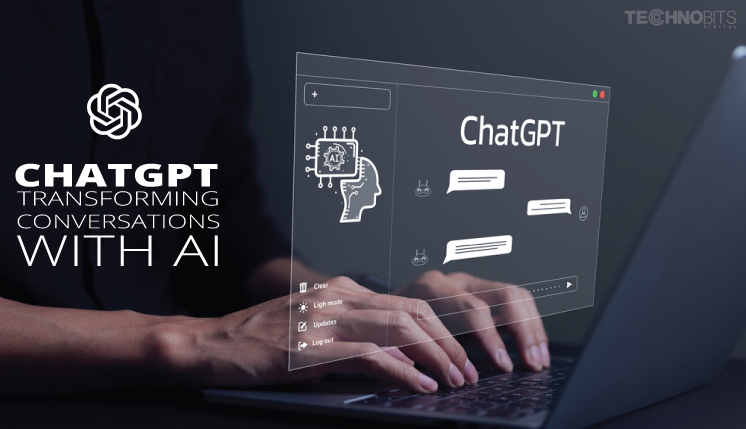Blog Detail
ChatGPT: Transforming Conversations with AI
Chat Gpt
Oct 18 2023

Artificial intelligence (AI) has come a long way recently, especially in natural language processing. The model ChatGPT, created by OpenAI, is among the field's most impressive innovations. ChatGPT is profoundly transforming conversations, customer service, and content creation. This blog will examine ChatGPT's definition, operation, uses, drawbacks, and potential to influence future human-computer interaction.
Introduction to ChatGPT
GPT-3's twin model, ChatGPT, stands for "Chat Generative Pre-trained Transformer." It is intended to comprehend conversational text and provide text responses that sound human. ChatGPT uses deep learning and neural networks. The system produces reactions by using the input it receives. Unlike conventional chatbots that follow predefined scripts, I will correct spelling, grammar, and punctuation errors. It can handle various topics and inquiries because it has been educated on multiple internet content.
How ChatGPT Works
The ChatGPT's neural network is a transformer deep neural network. Because of this architecture, it can process and output text with exceptional fluidity and coherence. A collection of words is used as input by the model, which then guesses the next word based on the conversational context.
Being a generative model, ChatGPT creates responses from scratch rather than relying on predefined ones. It accomplishes this by sampling by selecting the most likely word from a probability distribution over the vocabulary depending on the input and its internal linguistic patterns.
Applications of ChatGPT
ChatGPT can adapt and can be used for various purposes. I will ensure the text is free from spelling, grammatical, or punctuation errors. Including.
1. Customer Support: For quick and efficient customer service, many companies have integrated ChatGPT into their websites and applications. As a result, operations for customer support are now much more effective.
2. Content Generation: ChatGPT can help writers by providing ideas, producing text paragraphs, or guiding them through writing. It has proven to be a helpful tool for bloggers, authors, and journalists.
3. Language Translation: The language capabilities of ChatGPT go beyond English. It is a helpful tool for removing language barriers because it can translate content from one language to another.
4. Education: As a virtual tutor, ChatGPT may respond to students' inquiries and give explanations on a variety of topics.
5. Programming Assistance: ChatGPT is a tool for developers to seek help with code, debug problems, and develop creative programming solutions.
6. Creativity: ChatGPT can be a collaborative tool for musicians and artists, assisting them in developing fresh concepts and ideas.
Personal Assistance: For casual discussion, entertainment, and companionship, some people utilise ChatGPT as a digital companion.
Challenges and Limitations
Although ChatGPT is a strong tool, it is not without difficulties and restrictions:
1. Bias: Because ChatGPT has learned from the online text, which can contain biased language and opinions, it may unintentionally produce biased or improper content. These biases are being lessened through efforts.
2. Incorrect Information: The accuracy of the data that ChatGPT generates needs to be verified. If it has been exposed to errors during training, it may give wrong answers or information.
3. Lack of Context Understanding: Sometimes ChatGPT may be unable to comprehend the context of a conversation, resulting in irrelevant or absurd responses.
4. Ethical Concerns: Ethical questions are raised by the usage of ChatGPT in specific applications, including creating deep fakes or disinformation campaigns. Use must be done responsibly.
Future Prospects
ChatGPT's future appears bright. Several promising opportunities are in the distance:
1. Improved Accuracy: The accuracy and biases of ChatGPT are being improved by continuing research and development.
2. Multilingual Capabilities: The multilingual capabilities of ChatGPT are anticipated to increase, making it a crucial tool for international communication.
3. Specialised Versions: For particular businesses or domains, such as healthcare, finance, or legal services, there might be specialised ChatGPT versions.
4. Enhanced Chatbots: Businesses are expected to create chatbots powered by ChatGPT that are more advanced and capable of managing complex consumer interactions
5. Human-AI Collaboration: ChatGPT may make it easier for people and AI to work together more frequently, particularly when solving creative and practical problems.
User Tips
Users should keep the following advice in mind to get the most out of ChatGPT:
- Ask Clear Questions: To receive more accurate and precise responses from ChatGPT, it's essential to ask clear and concise questions.
- Double-Check Information: It is crucial always to double-check the information provided by ChatGPT. This is especially important when making critical decisions or conducting research. By verifying the data, you can avoid potentially costly mistakes. Therefore, it is always advisable to take the necessary steps to ensure the accuracy of the information before acting on it.
- Monitor for Bias: It's essential to be aware of any possible biases in the answers and carefully evaluate the data to ensure accuracy. Remember to double-check for any spelling, grammar, or punctuation errors.
- Experiment and Learn: If you are curious to discover more about ChatGPT, you can experiment with it yourself. By doing this, you will be able to fully explore the entire range of possibilities. I'll make sure to correct any spelling, grammar, and punctuation errors. Features and restrictions that exist on the platform. By engaging with ChatGPT directly, you can learn how it works and how to get the most out of it. So, don't hesitate to play around with it and see what you can discover.
TAGS
Australia +61 4 7038 7624 India +91 97265 89144
We truly care about our users and our product.






